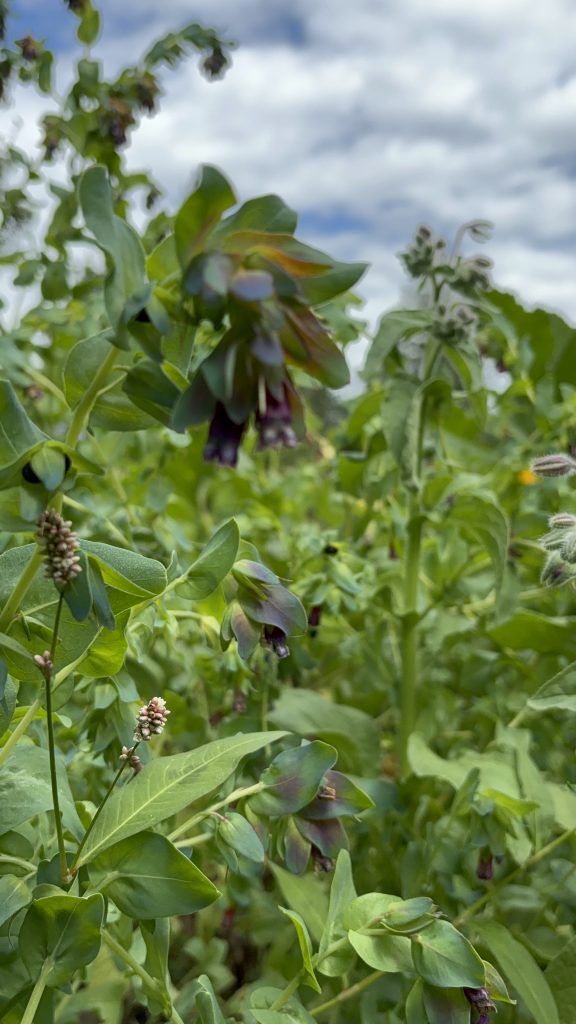New to Me: Wonderful, Surprising Honeywort
At the Sandpoint Farmer’s Market early this June, some beautiful plant starts caught my eye.
Novelty Strikes Again
They had very blue rounded leaves, a mounded habit, a dusky quality — and gave the aura of being robust and mysterious. I was intrigued me with the fact that I had definitely never seen them before and wanted to know more. Add to that the fact that they are a medieval plant? They had me instantly.

Just Gorgeous
Light white spots freckled their leaves and, on some leaves, there was a tiny notch at the tip. Neatly marked Blue Kiwi Honeywort, I took the plunge.
Two healthy little babies came home with me and were planted directly into the lower garden a couple of feet apart, one of this year’s experiments.
Striving Toward the Sun
They grew up well and then began to shoot out flowers from panicles that reminded me of Russian nesting dolls. They got larger and larger until they were about 2.5 or 3 feet tall!
Pollinator Insistence
Even before the blossoms opened, pollinators were knocking the doors down! Bumblebees were the main visitors, and they vigorously fed on the pollen, creating a distinct, rhythmic buzzing sound as they did so.
Each blossom is said to contain a drop of honey, and it must be delicious – we are talking about some motivated pollinators here!
I may be going out on a limb, but I think the bumblebees had to work pretty hard to get the pollen — because their big bumblebee butts were often too ample to fit inside the flower.
Click to see to see a great image (and other info) comparing bumblebees and honeybees.

The flowers themselves are bell-shaped and tilt downward. They are a beautiful saturated royal purple.
Just beautiful — I had an instant love for these super-useful pollinator plants.
Waning and Ensuring Next Year’s Crop
They kept a strong and continual bloom on until late September when they began to drop blossoms and set seed. When the blossoms drop, you can see that the innermost part of the blossom is ringed in yellow.
Then I started looking for seeds to show my friends at the upcoming seed saving workshop we are planning to attend.
Unique! Beautiful! Seeds!
When I found them, I was downright flabbergasted at the size, shape and color! Large for the size of the blossom, they are jet black, they are attached with a lot of surface area to the plant but drop readily.
Shaped like bound Chinese feet (I know, weird, there is no other analogy!), they have two flat sides and one curved.



Volunteers Abound?
Since honeywort is related to borage, another pollinator star, I was not surprised at their probable self-seeding prowess.
I suspect a new crop of volunteers next spring, and will keep you posted.
Until then, here’s to falling in love with plants, over and over again!
Latin Lite for Plant Lovers
Wort. The suffix “-wort” simply means “plant.” In earlier centuries, plant common names often referred to physical characteristics, resemblance, or recommended medicinal uses.
Officinalis, or officinale, is a Medieval Latin word for useful plants with applications in medicine, herbalism and cookery.
The Latin officinalis also refers to the name of a monk's storeroom, the officina, where medicines and herbs were stored.
BUY HONEYWORT SEEDS at Baker Creek Heirloom Seeds.
RESOURCE:
Bumblebees of the Western United States
POSTSCRIPT:
I apologize for not recalling the booth I bought them from, because they were exceptionally healthy, and the proprietress told me they were planted in 100% compost — it looked rich and alive. If anyone out there knows, please contact me. I like to give credit where credit is due.


0 Comments